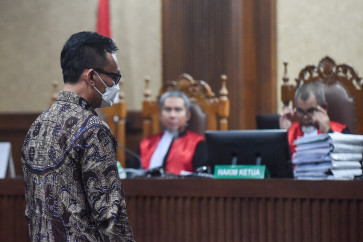Popular Reads
Top Results
Can't find what you're looking for?
View all search resultsPopular Reads
Top Results
Can't find what you're looking for?
View all search resultsJILF showcases Indonesia’s ‘wild literature’
Mandatory reading material: A visitor looks at the original copies of Balai Pustaka’s canons
Change text size
Gift Premium Articles
to Anyone
M
andatory reading material: A visitor looks at the original copies of Balai Pustaka’s canons. Some of the books are still reprinted and used in schools.(JP/Tertiani ZB Simanjuntak)
The exhibition’s title, Colonial Bastard: The Forbidden Fictions, is as intriguing as the collection of magazines, newspapers and pocketbooks that were published in the country since the early 1900s.
Although only a few of them had been put on display at Teater Kecil in the Taman Ismail Marzuki arts and culture center in Central Jakarta, the numbers of copies, as well as the varied genres, were enough to show how rich the nation’s literary tradition was in the past.
“While we question the nation’s reading interests today, we have historical records as a comparison,” Isyana Artharini, one of the curators of the Jakarta International Literary Festival, told The Jakarta Post.
“This exhibition shows the richness of the knowledge of the writers, how they chronicled the era, giving details on what really happened at that time,” she added.
The theme of the exhibition, which ran until last Saturday, is based on research conducted by writers Berto Tukan and Sulaiman Harahap in their search for the literary traditions of the colonial era.
The researchers found the vast number of reading materials that were labeled bacaan liar (wild literature) by the colonial authorities in contrast to the “curated” works selected and published by the literature bureau, today known as the Balai Pustaka.
The exhibition area is divided into three sections; the first two are for the shunned reading materials.
The farthest part of the area is for the works of writers affiliated with the early period of the national movement, including magazines and newspapers that were scanned from the collection of the National Library.
During the period, the colonial authorities also put the label on opposition novels such as Student Hidjo (Green Student) by Mas Marco Kartodikromo, Njai Permana by Tirto Adisoerjo and Hikajat Kadiroen (Kadiroen’s Story) by Semaun.
In the middle is a collection of reading material from the Peranakan-Chinese (Chinese Indonesian) literary tradition, the scanned copies of which were obtained from the Museum Pustaka Peranakan Tionghoa (Chinese Indonesian Literature Museum) in Serpong, Banten.
Most of them were written as fiction that could fall into the romance and Victorian categories; some of them are translated works and adaptations.
“But there are some 2,000 names of Peranakan writers with their original works recorded, although not all of them were well documented. Through this exhibition, we want to show to the public the reading material that had been marginalized at that time, as well as the messages the writers wished to get across,” Isyana said.
Closer to the entrance was Balai Pustaka, a collaborator of the exhibition. The publishing company lent its collection of the original copies of “canonized” novels from the colonial era that are still being used today as reading material in schools.
The wide circulation of “curated” reading material backed by the colonial authorities and the labeling of “wild literature” further eliminated the literary tradition of that era.
There were standardized language and requirements for a literary work to be able to enter the Balai Pustaka canon.
For example, according to Isyana, the story had to contain certain guided morals and female writers had to support the appropriate family structure in their works.
“The irony is that Balai Pustaka at that time used the modern Indonesian language as a means to silence resistance literature, or Peranakan literary works, as they commonly used low Malay peppered with Dutch or Chinese words,” said Isyana.
“Such an unseen curatorial process still exists today,” she added. “Most of us don’t understand how a certain literary work got selected to be translated into a foreign language and brought to the international stage for promotion.” (ste)










